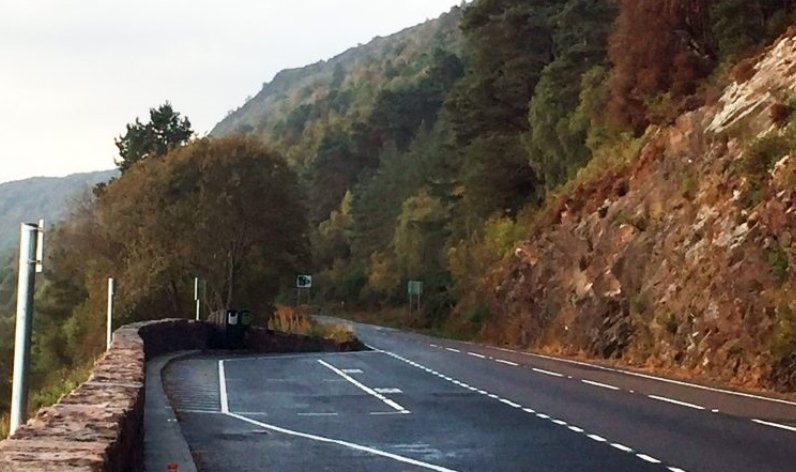BEAR Scotland’s Grotaig site welcomed the Cabinet Secretary for Transport this week as the government ramps up investment in protecting vital transport routes.
Climate Pressure on Scotland’s Roads in Focus
The A82 winds its way through some of Scotland’s most dramatic scenery — but also some of its most challenging terrain. At Grotaig, a rugged section on the North West trunk road network, the risks are more than scenic. Rock slopes loom above traffic, and heavy rainfall combined with warming temperatures have increased the chances of landslides and falling debris.
Fiona Hyslop MSP arrived on Tuesday to see first-hand how BEAR Scotland and Forest & Land Scotland are tackling those hazards. The project has already seen more than 11,000 square metres of rock netting installed earlier this summer, a lattice of steel designed to catch dislodged rocks before they hit the carriageway.
The Cabinet Secretary didn’t mince words about the scale of the challenge. She said Scotland’s wetter winters and changing ground conditions are forcing a rethink on how roads are maintained and protected.

£714 Million Investment and a Long View
Standing on the roadside, Hyslop pointed to the bigger picture — this isn’t a one-off fix. The Scottish Government has earmarked £714 million for the trunk road network in the current budget year, a figure that covers maintenance, resilience upgrades, and safety improvements.
She called the Grotaig work a “perfect example” of proactive planning. Not just patching a problem after a landslide but preventing it before lives are put at risk and businesses are cut off.
It’s not the only area getting attention. Transport Scotland’s maintenance schedules list multiple projects along the A82 and other vulnerable routes, often involving geotechnical surveys and slope stabilisation.
On-Site: Engineering Meets Landscape
BEAR Scotland’s North West Unit Representative, Euan Scott, greeted the minister against a backdrop of scaffolding and high-tensile mesh clinging to the rock face. Crews in safety harnesses were still scaling parts of the slope to secure the final sections.
One worker described the effort as “like working on a cliff edge with the weather changing every half hour.” The location itself, wedged between a steep rise and the loch, leaves little room for error — or for heavy machinery.
The current phase is about shoring up the slope, but the team is already running tests to plan future interventions. That includes:
-
Detailed drone mapping to detect new cracks or movement
-
Installing sensors that can trigger road closures if the slope shifts
-
Soil and rock sampling to understand how freeze-thaw cycles weaken the cliff
Why the A82 Matters
The A82 is more than a scenic drive for tourists heading to the Highlands. It’s a key freight and commuter link, threading from Glasgow through Fort William and beyond. Any closure ripples through the economy.
| Section of A82 | Average Daily Traffic (vehicles) | Closures in Last 5 Years |
|---|---|---|
| Crianlarich–Fort William | 5,600 | 3 (weather/landslip) |
| Fort William–Inverness | 4,200 | 5 (weather/landslip) |
| Glasgow–Crianlarich | 9,800 | 2 (weather) |
Even a short disruption can mean hours-long detours for hauliers, tourism operators, and locals heading to work or medical appointments.
Local Communities Watch Closely
For residents in the North West, the work is a relief — but also a reminder of how exposed they are. A shopkeeper in nearby Invermoriston said she’s seen a “big shift” in the weather over the past decade. “We get downpours that just don’t stop. You see the hillsides streaming with water, and you know the road could be next.”
Not everyone is convinced enough is being done. Some campaigners argue that more money should go into alternative routes and ferry links to avoid single points of failure.
Hyslop acknowledged the pressure but insisted that “keeping the trunk road safe and operational” remains the top priority for now.
Beyond Grotaig: What Comes Next
The Grotaig stabilisation fits into a rolling programme of geotechnical works across Scotland. BEAR Scotland’s crews are already working on other high-risk slopes, and more sites are in the pipeline for 2026.
Scott said the goal is to make the road “as resilient as the landscape is beautiful,” but he admitted there will always be a need for vigilance. “You can’t stop the mountain from moving,” he said. “You just have to be ready for it.”
The Cabinet Secretary’s visit ended with a short closed-door meeting with engineers and local officials. While no new projects were announced on the spot, there’s an expectation that climate adaptation will take a bigger slice of transport budgets in the coming years.


















